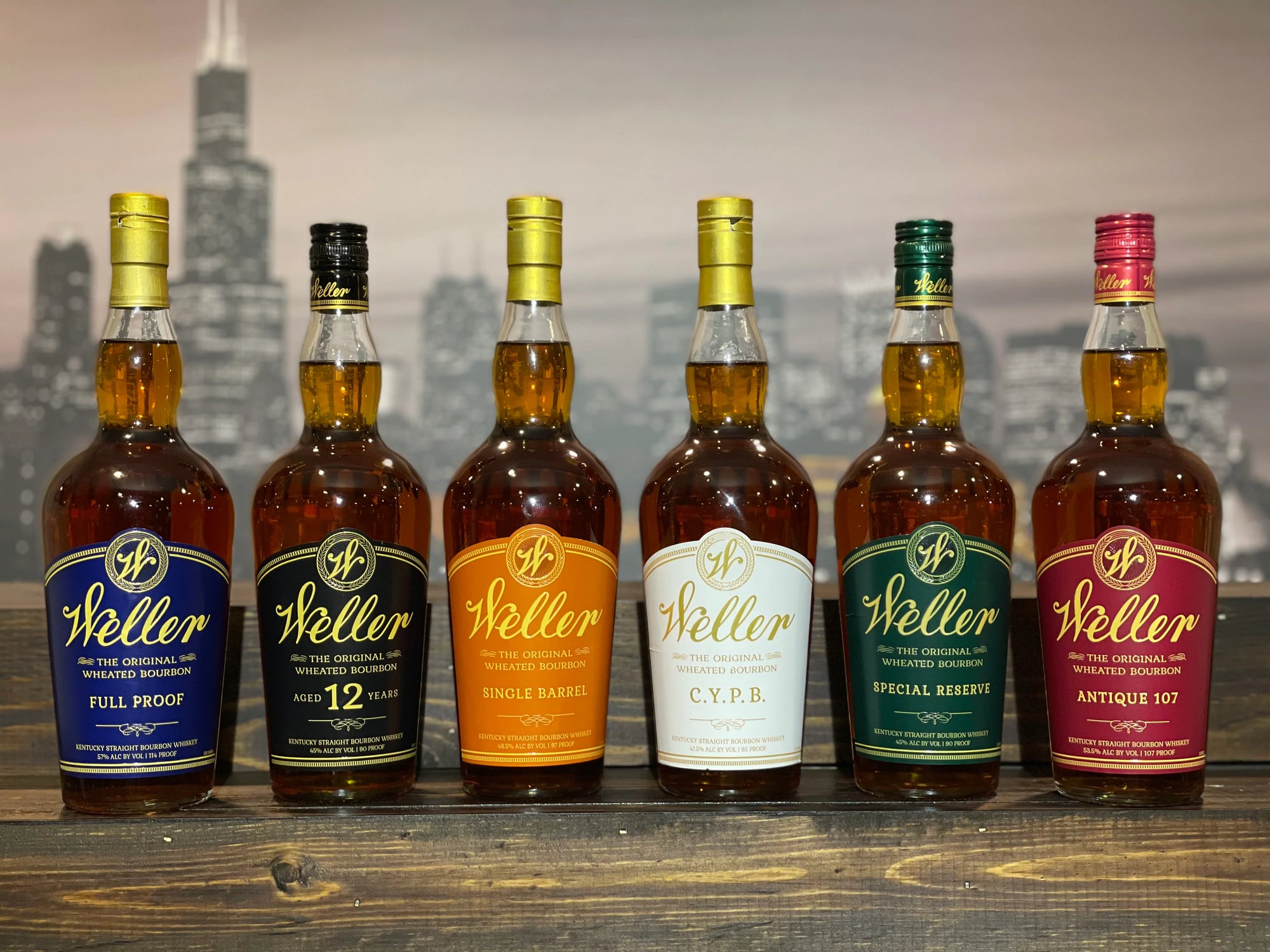W.L. Weller Bourbon: A Legacy Unveiled
February 10 2024

In the world of bourbon, W.L. Weller Bourbon holds a revered position, boasting a legacy that intertwines deeply with the history of American whiskey. Known for its pioneering use of wheat instead of rye in its mash bill, W.L. Weller bourbon offers a smoother, softer flavor profile that has captivated the palates of whiskey lovers worldwide. This comprehensive guide delves into the heart of W.L. Weller, exploring every bottle ever carried by the brand, including those rare gems that aficionados dream of adding to their collections.
Introduction to W.L. Weller Bourbon
In the lush landscapes of Kentucky, where the art of bourbon crafting has been perfected over centuries, W.L. Weller stands out as a testament to innovation and excellence. Founded by William Larue Weller in the late 19th century, the distillery introduced the revolutionary idea of using wheat in the bourbon mash bill, setting a new standard for smoothness and flavor. Today, W.L. Weller's bourbons are celebrated not just for their historical significance but for their unparalleled quality and taste.
The Signature Wheated Mash Bill
W.L. Weller's choice to use wheat instead of rye offers a gentler, more approachable flavor, distinguishing its bourbons from the spicier rye-based counterparts. This section explores the impact of this decision on the bourbon industry and how it has shaped the Weller brand's identity.
W.L. Weller Special Reserve: The Welcoming Entry
The Special Reserve is often the first encounter many have with the Weller brand. Known as "The Original Wheated Bourbon," it features a smooth, mild, and sweet palate, making it a perfect introduction to the world of Weller. With its accessible flavor profile and gentle warmth, the Special Reserve has become a staple for both bourbon newcomers and seasoned enthusiasts.
W.L. Weller Antique 107: Bold and Beautiful
Stepping up in intensity, the Weller Antique 107 is admired for its robust flavor profile, marked by a higher proof that amplifies its wheat-forward character. This bourbon offers a harmonious balance of caramel and vanilla notes, underpinned by a warm, oaky finish. It's a favorite among those who appreciate a stronger, more pronounced bourbon experience.
W.L. Weller 12 Year Old: The Age Statement Excellence
Aged for 12 years, this expression is a testament to the depth and complexity that time imparts on bourbon. The Weller 12 Year Old is renowned for its rich flavor profile, featuring layers of caramel, dark fruit, and chocolate, all seamlessly integrated with the smoothness that wheated bourbons are known for. Its scarcity and high demand have made it a coveted bottle for collectors.
Rare and Limited Editions
W.L. Weller C.Y.P.B. (Craft Your Perfect Bourbon)
A unique offering in the bourbon world, C.Y.P.B. stands for "Craft Your Perfect Bourbon." This limited edition was born from an interactive experience on the Weller website, where enthusiasts could vote on their preferred bourbon characteristics. The result is a perfectly balanced wheated bourbon, tailored by popular demand, showcasing the power of community engagement in the bourbon crafting process.
W.L. Weller Full Proof: The Barrel Strength Offering
Bottled at the same proof it entered the barrel, the Full Proof edition delivers Weller's signature wheated bourbon profile with unadulterated intensity. This expression offers bourbon purists the opportunity to experience the raw, powerful flavors of Weller bourbon, complete with a rich mouthfeel and an enduring finish.
W.L. Weller Single Barrel: A Unique Expression

Each bottle of Weller Single Barrel is drawn from a single cask, offering a unique and unparalleled tasting experience. This expression highlights the nuances of the distillation and aging process, with each barrel imparting its own character to the bourbon. It's a rare find that offers insight into the subtleties of bourbon craftsmanship.
The Pappy Van Winkle Connection
W.L. Weller is often mentioned in the same breath as the legendary Pappy Van Winkle, due to their shared use of a wheated mash bill. This section will explore the relationship between these two iconic brands and why Weller is sometimes referred to as the "Poor Man's Pappy."
Collecting W.L. Weller
For collectors, W.L. Weller bourbons represent not just a passion for fine whiskey but an investment in history and craftsmanship. This guide will offer tips for collectors on acquiring, storing, and appreciating Weller's rare and limited bottles, including strategies for navigating the competitive bourbon collecting landscape.
Conclusion: The Timeless Appeal of W.L. Weller Bourbon
W.L. Weller bourbon embodies the spirit of innovation, tradition, and excellence. From its groundbreaking wheated mash bill to its acclaimed limited editions, Weller continues to set the standard for quality bourbon. Whether you're a seasoned collector or a curious newcomer, the world of W.L. Weller offers a rich and rewarding journey through the heart of Kentucky's bourbon heritage.
FAQs
What makes W.L. Weller bourbon unique? W.L. Weller bourbon stands out due to its use of wheat in the mash bill instead of the traditional rye. This substitution offers a smoother, softer flavor profile, with less of the spicy bite often associated with rye bourbons. Additionally, the brand's rich history and commitment to quality over centuries contribute to its uniqueness in the bourbon world.
How does the wheated mash bill affect the flavor profile of Weller bourbons? The wheated mash bill gives Weller bourbons a distinctively smooth, round, and full-bodied flavor. Drinkers often note the presence of sweeter, softer notes like caramel, vanilla, and baked bread. This makes Weller bourbons particularly approachable for newcomers while still offering complexity and depth that connoisseurs appreciate.
Why is the W.L. Weller 12 Year Old so sought after? The W.L. Weller 12 Year Old is highly prized for several reasons. Its extended aging process allows for a deeper, more complex flavor profile, with rich notes of caramel, oak, and dark fruits. Its scarcity, due to limited production and high demand, also adds to its allure. Furthermore, its association with the Pappy Van Winkle line, which shares a similar wheated mash bill, has elevated its status among bourbon enthusiasts.
Can you explain the connection between W.L. Weller and Pappy Van Winkle? W.L. Weller and Pappy Van Winkle bourbons are both produced by the Buffalo Trace Distillery and share a wheated mash bill, which is somewhat rare in the bourbon industry. This shared heritage has led to comparisons between the two, with some enthusiasts referring to Weller as a more accessible alternative to the highly coveted and often expensive Pappy Van Winkle bottles. The connection is primarily based on their similar flavor profiles resulting from the wheat component in their recipes.
How can I start collecting W.L. Weller bourbons? Starting a collection of W.L. Weller bourbons requires patience, research, and sometimes a bit of luck. Begin by familiarizing yourself with the different expressions and understanding which bottles are more readily available versus those that are rare or limited editions. Building relationships with local liquor stores, joining bourbon enthusiast groups, and participating in bourbon lotteries or releases can also increase your chances of acquiring sought-after bottles.
What tips do you have for tasting and appreciating W.L. Weller bourbon? To fully appreciate W.L. Weller bourbon, start by tasting it neat (without ice) at room temperature to understand its pure flavor. Use a tulip-shaped glass to concentrate the aromas. Take small sips, letting the bourbon coat your palate, and pay attention to the initial flavors, mid-palate development, and finish. As you become more familiar with its profile, you can experiment with adding a few drops of water to open up the flavors or trying it with ice to see how it changes the experience.

0 comments